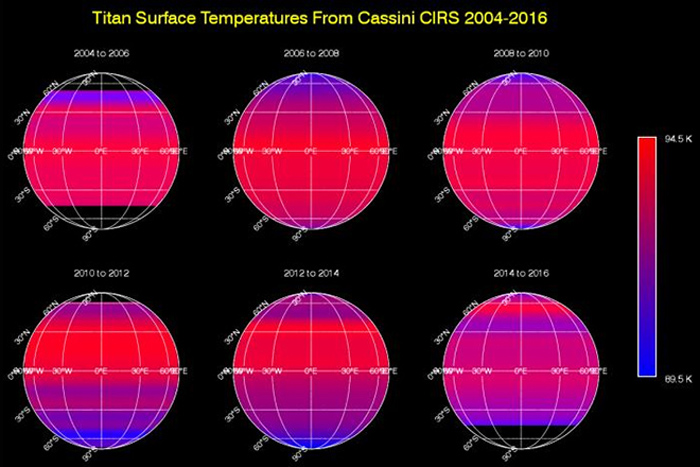'Doctor' Cassini Takes Titan's Temperature

When you go for your annual health checkup, you might expect the doctor to take your temperature. Well, it looks like Saturn's moons also get the same treatment, courtesy of NASA.
PHOTOS: 10 Years Later: When Huygens Landed on Titan
Seen below is an animation of how Titan's global temperature has changed over the past 12 years and you may notice a trend: the south gets cooler while the north heats up.
Using Cassini's Composite Infrared Spectrometer (CIRS) instrument, mission scientists have been able to monitor the thermal infrared radiation coming from the moon's surface. Titan is the only moon in the solar system with a thick atmosphere, so gauging its surface temperature can be difficult. However, the Titan atmosphere has what's known as a "spectral window" at an infrared wavelength of 19 microns, allowing this type of thermal radiation to pass, without being absorbed by atmospheric gases, into space.
NEWS: Titan Appears Earth-Like in New Image
The atmospheric haze still makes measurements hard, however, and the global temperatures have been averaged from east-to-west, creating the banded temperature structure.
Cassini arrived in Saturn orbit in 2004 when Titan's southern hemisphere was in summer. As expected, during this time, the southern hemisphere was at its warmest. "Warm" is relative, however. Saturn orbits the sun at nearly 10 times the distance Earth orbits the sun, so sunlight is very weak by the time it reaches Titan and has a less dramatic heating effect than on our planet.
Breaking space news, the latest updates on rocket launches, skywatching events and more!
For example, the peak summer temperature on Titan has been measured at -292 degrees Fahrenheit (-179.6 degrees Celsius or 93.6 Kelvin) near the equator, but when measured at the poles during this time, the temperature was only 6 degrees Fahrenheit (3.5 degrees Celsius or Kelvin) cooler.
PHOTOS: Cassini's 10th Year: Recent Saturn Mind Blowers
Saturn orbits the sun once every 30 years, so its seasons last 7.5 years. Cassini, being a long duration mission to the ringed gas giant, has been able to watch seasonal changes in Saturn's atmosphere for 12 years, but in this case has watched 2 seasons unfold on Titan's surface.
Alas, Cassini's mission is nearing an end. Running low on the fuel it uses for propulsion, mission managers are planning a "Grand Finale" that will see the orbiter alter its trajectory around Saturn so that it flies through the planet's ring plane. Eventually, by September 2017, Cassini will drop closer to Saturn's upper atmosphere, burning up as a human-made meteor.
For more detail on how these Titan observations were made, browse the NASA news release.
Originally published on Discovery News.
Ian O'Neill is a media relations specialist at NASA's Jet Propulsion Laboratory (JPL) in Southern California. Prior to joining JPL, he served as editor for the Astronomical Society of the Pacific‘s Mercury magazine and Mercury Online and contributed articles to a number of other publications, including Space.com, Space.com, Live Science, HISTORY.com, Scientific American. Ian holds a Ph.D in solar physics and a master's degree in planetary and space physics.
